How to make a delicious gravy and plenty of it. Part of my step-by-step guide with FREE time plan for making a delicious roast dinner. 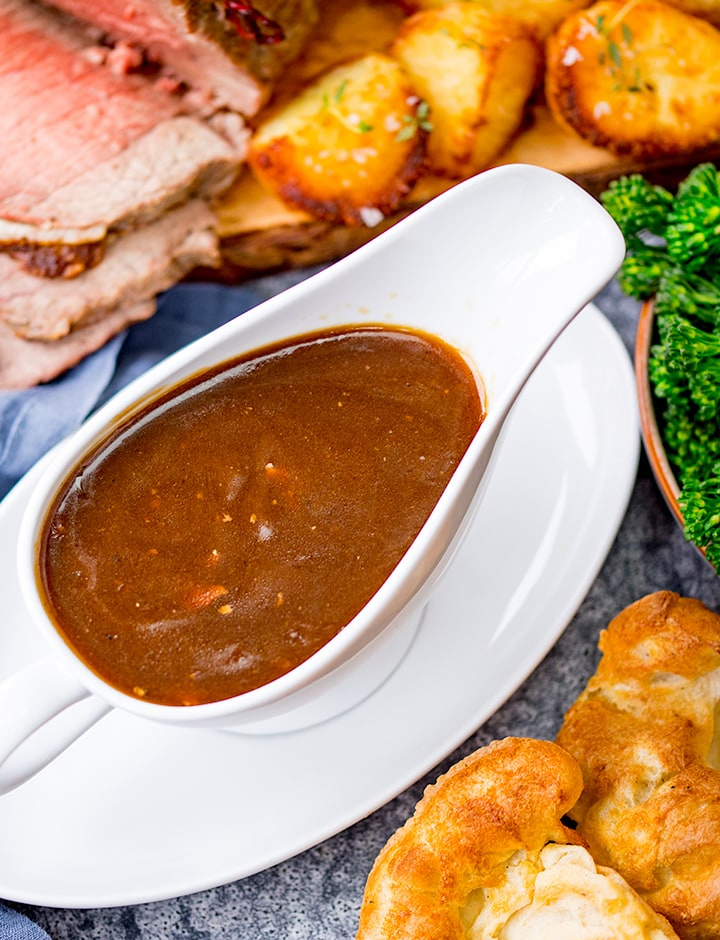
I kind of get the whole ‘au jus’ thing – a little trickle of meaty, flavourful sauce on your slices of meat, whilst leaving the potatoes and vegetables bare, so they look vibrant and colourful.
But I don’t want a little drizzle of au jus. I want gravy. And loads of it!
I want it all over my roast beef, roast potatoes and veggies. I want an extra puddle of it on my plate for dipping purposes, and I want my yorkshire pudding filled with it, so you get the excitement of cutting your yorkshire pudding open like a gravy river whooshing from a crispy golden dam.
The rest of my family is the same, so when I make a roast dinner, I have to make that gravy stretch really far. But it has to be packed full of flavour too.
This is my comprehensive guide for making a big batch of gravy from the meat juices of your roasted meat.
Which meat makes the best gravy?
Chicken
Good quality chicken can produce delicious gravy. Go with a larger chicken (we all want roast chicken leftovers right?), preferably free-range organic. This is because they’re usually fed a better diet and move around more, which produces a more tender meat.
Brush all over with olive oil and season with plenty of salt and pepper before roasting.
Lamb
Lamb leg or shoulder is my favourite meat for a roast dinner. It’s a naturally fattier meat, with lots of flavour that makes tasty gravy. I love to add a teaspoon of mint sauce to my lamb gravy.
Again, brush all over with olive oil and season with plenty of salt and pepper before roasting.
Pork
Whilst I love roast pork with crackling, I think it’s the most difficult to get a good flavour from. The layer of fat and skin ensure a pork joint will be lovely and juicy, but the meat juices don’t have much depth to them.
I always add a mixture of beef and chicken stock (from a crumbled stock cube or liquid stock) to pork meat juices to increase the flavor. Using both results in a nice flavour balance for pork.
A pork crackling joint should be scored and rubbed with plenty of salt before roasting.
Beef
Personally, I think a good quality joint of beef will give you the best flavour gravy.
Look for a joint with a good amount of fat on top and little veins of fat (not gristle) running through it. I like a ribeye joint when I’m splashing out, or for a regular, less expensive cut, a good quality beef topside or top rump joint (although a little leaner than ribeye), is good too.
Cooked in the oven with a splash of olive oil and a good sprinkling of salt and pepper, you’ll get some tasty meat juices for your gravy.
I have used brisket in the past too, but as this is a tougher cut of meat, it requires longer cooking. Because it doesn’t product much in the way of meat juices, I add a half bottle of red wine to the pan and cover the brisket before cooking low and slow to ensure I have good tasting liquid for the gravy.
Vegetable trivet or not?
Some chefs like to roast their meat on top of a trivet of onions and carrots. The trivet can help to keep the base of the meat moist, and the caramelization of the veggies, once squished around a little at the end of cooking, can add flavour to the gravy. These veggies are then discarded.
Personally I hardly ever use a vegetable trivet. I prefer the meat juices to drip directly into the pan, and then start to caramelize on the base of the pan. It’s these lovely darkened caramelized juices that give the gravy the best flavour in my opinion. I can’t stand the thought of letting the vegetables soak up the juices, then trying to squish that flavour out of the veggies before discarding them. That’s flavour that’s being thrown away!
The times when I would use a vegetable trivet would be for something like a brisket – which takes a long time to cook, and needs all the help with moisture it can get. I add wine into the base of the tin too, so as the meat juices are released into the veggies, they’re also going into the wine.
I also may use a vegetable trivet if I’m cooking a huge piece of meat – like a large turkey. Again, you’re cooking the turkey for a long time, so it needs a little help with the moisture. Also, roast turkeys produce lots of meat juices, so you won’t be chucking it all away when you discard the vegetables.
Should I add stock cubes/stock pots/concentrated liquid stock?
100% yes! If you want lots of gravy, you’re going to need some help. The meat juices from your roasting joint will generally have a lovely, deep flavour, but they won’t go very far. Adding the vegetable water from steaming/boiling your vegetables, as well as a couple of crumbled up stock cubes will make the gravy stretch much further, whilst still ensuring the flavour from the meat juices shines through.
I personally like chicken or beef oxo cubes (I use one per cup/240ml water) or even better if i have some homemade stock in the freezer.
If i’m making a gluten free version, I use Essential Cuisine concentrated liquid stock/glace or powder. It’s more expensive than Oxo cubes, but has a fantastic flavour (fyi – I’ve worked with them in the past, but I’m not being paid for this mention in any way). I think it’s only available in the UK, online or in larger farm shops. If you’re in the US and you know of a fantastic gluten free stock cube/powder/liquid, let me know in the comments and I’ll add it into this post.
Cornflour/cornstarch method or the roux method?
I’m probably going to shock you now, but I prefer the cornflour/cornstarch method.
The roux method (which involves sprinkling flour into the meat juices, stirring with a whisk to form a paste, then slowly adding liquid) is more traditional, but has a higher likelihood of going wrong – producing a gravy with a floury taste if the flour isn’t cooked out enough, or lumpy gravy if you’re not really careful whilst adding the stock. Some people believe the roux method is more flavourful, but I don’t think there’s a difference in flavour.
Using the cornflour/cornstarch method means you can add all liquid in first (so you can ensure you have the right quantity of gravy), then add the cornstarch slurry to thicken. It also produces a shiner gravy that’s gluten free (providing you use gluten free stock)
I’ll include instructions for both methods in the recipe card below.
Using bones for gravy (brilliant for make ahead gravy)
Is it gross that I have bag full of bones in my freezer?
Whenever we have a roast – chicken, lamb, beef – basically anything roasted on the bone, I always save the bones. Place them in a bag, and keep adding to that bag. Once you have a couple of chicken carcasses or a few bones, add them all into a large stock pot (mix them up – lamb bones, beef bones, chicken carcass – they can all go in together) with a a couple of roughly chopped onions (no need to peel), a couple of broken up carrots (no need to peel), a stick of celery and 1/2 tsp each of salt and pepper. Cover with water – so it nearly reaches the top of the pan, then bring to the boil. Simmer for 3-4 hours until the liquid has reduced by three-quarters. Leave to cool a little, and strain the liquid into a bowl. Give the bones and veggies a good squeeze with a spoon to get all the liquid out.
Cool and freeze this stock for later or use right away. It makes a fantastic base for soup, or you can heat it and stir through some cornstarch slurry (2 tbsp cornflour/cornstarch with 5 tbsp cold water) until thickened. Add in a splash of gravy browning if you like a darker gravy. Add in a crumbled stock cube if you want even more flavour.
Making gravy when you haven’t got any meat juices (i.e for sausages)
So you want to make toad in the hole or chips and gravy – without resorting to bisto and water (sorry bisto).
You’ve got a few options:
- Make some gravy from that delicious stock you made and froze earlier after boiling up all of those bones (see above).
- Make an onion-based gravy with caramelized onions. Fry a finely sliced onion, along with 1 tsp light brown sugar and 2 tbsp of unsalted butter over a low heat for 15-20 minutes, until starting to caramelize. Sprinkle over 2 tbsp flour and stir. Cook for 2 minutes to cook out the taste of the flour. Add in 2 cups (420ml) of hot beef stock (water plus 2 stock cubes), slowly, whilst stirring all the time, until the gravy thickens. You’ll see I’m using the roux method for this, but it’s less likely to go wrong in this case, as the flour adheres to the onions initially, which helps to prevent a lumpy gravy. Add a splash of Worcestershire sauce and season with salt and pepper before serving.
- Add water to a pan with a mixture of stock cubes (chicken and beef, lamb too if you have it). This mixture gives a nice balance of flavours. Use one stock cube for every cup (240ml) of water. Or use concentrated liquid stock (again, i’d recommend a mixture of the Essential cuisine liquid stocks/glaces). Bring to the boil, then stir in a cornstarch slurry (2 parts cornflour/cornstarch mixed with 5 parts cold water) using a whisk until thickened. Season with salt and pepper.
The gravy:
(fyi – i’ve included instructions for the roux method in the recipe card below as well).
Heat the meat juices in the roasting tin (ensure your roasting tin can take direct heat):
Sprinkle on a couple of crumbled stock cubes or add in a couple of teaspoons of concentrated liquid stock:
Stir together whilst pouring in the vegetables water from boiling steaming your vegetables and potatoes. Bring to the boil and lightly season with salt and pepper.
Stir in a simple cornstarch slurry (2 parts conrflour/cornstarch mixed with 5 parts cold water) using a whisk, until thickened.
Allow to bubble. Add any meat juices from the rested meat. Check for seasoning and add a little more salt and pepper if needed.
Serve immediately. Or turn off the heat until the rest of your roast dinner is ready and reheat just before serving. If you’re short on hob space, pour into a microwaveable jug and reheat in the microwave right before serving.
This gravy is part of my ‘How to make a Roast Beef Dinner step-by-step timeplan‘ post. Check it out for easy to follow instructions on making a mouthwatering roast beef dinner!
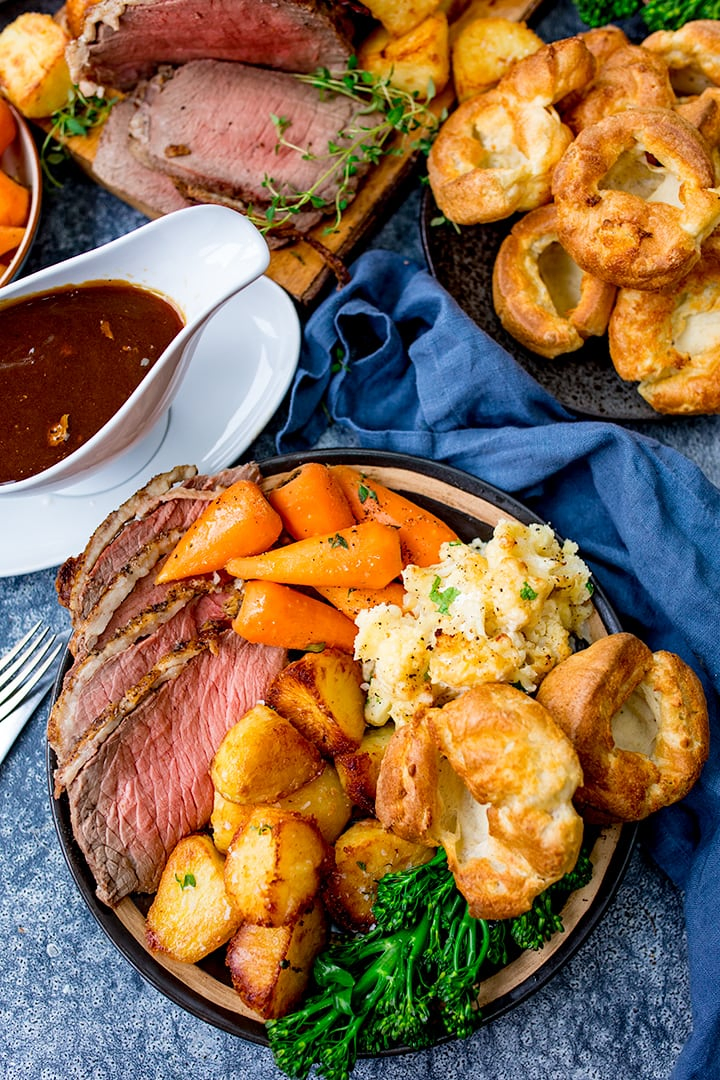
How to make Gravy:
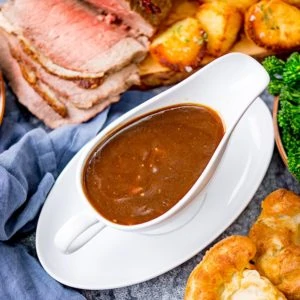
How to make gravy
Ingredients
- meat juices from your roasted meat
- 2-3 crumbled stock cubes chicken, beef or lamb, depending on which meat you've cooked, or a mixture of chicken and beef for gravy for roast pork or 3 tsp concentrated liquid stock
- 720 ml (3 cups) hot vegetable stock from your boiled/steamed vegetables and potatoes
- ¼ tsp salt
- ¼ tsp black pepper
- 2 tbsp cornflour/cornstarch
- 5 tbsp cold water
- ¼ tsp gravy browning optional
Instructions
- Heat the meat juices in the roasting tin (ensure your roasting tin can take direct heat).meat juices from your roasted meat
- Sprinkle on the crumbled stock cubes (or add the liquid stock).2-3 crumbled stock cubes
- Stir together whilst pouring in the hot vegetable water. Bring to the boil and lightly season with salt and pepper.720 ml (3 cups) hot vegetable stock, 1/4 tsp salt, 1/4 tsp black pepper
- Stir in a the cornstarch slurry using a whisk, until the gravy thickens.2 tbsp cornflour/cornstarch, 5 tbsp cold water
- Allow to bubble. Add any meat juices from the rested meat. Check for seasoning and add a little more salt and pepper if needed.
- If you want the gravy to be a darker brown, stir in the gravy browning.1/4 tsp gravy browning
- Serve immediately. Or turn off the heat until the rest of your roast dinner is ready and reheat just before serving. If you're short on hob space, pour into a microwaveable jug and reheat in the microwave right before serving.
Notes
Roux method:
Ingredients:- Meat juices from your roasted meat
- 2 tbsp plain (all purpose) flour
- 2-3 crumbled stock cubes (chicken, beef or lamb, depending on which meat you've cooked, or a mixture of chicken and beef for gravy for roast pork) or 3 tsp concentrated liquid stock
- 3 cups (720ml) hot vegetable stock - from your boiled/steamed vegetables and potatoes
- 1/4 tsp salt
- 1/4 tsp black pepper
- 1/4 tsp gravy browning (optional)
- Heat the meat juices in the roasting tin (ensure your roasting tin can take direct heat).
- Sprinkle on the flour and mix together with a whisk to form a thick paste.
- In a jug, mix together the crumbled stock cubes and hot vegetable stock. Slowly pour this stock into the roux whilst stirring all the time with a whisk.
- If you have any further meat juices from the rest meat, pour them in now.
- Bring to the boil, and slowly stir with the whisk until thickened.
Season with with salt and pepper.
If you want the gravy to be a darker brown, stir in the gravy browning.
Serve immediately. Or turn off the heat until the rest of your roast dinner is ready and reheat just before serving. If you're short on hob space, pour into a microwaveable jug and reheat in the microwave right before serving.
Nutrition
Nutrition information is automatically calculated, so should only be used as an approximation.
Some of the links in this post may be affiliate links – which means if you buy the product I get a small commission (at no extra cost to you). If you do buy, then thank you! That’s what helps us to keep Kitchen Sanctuary running. The nutritional information provided is approximate and can vary depending on several factors. For more information please see our Terms & Conditions.
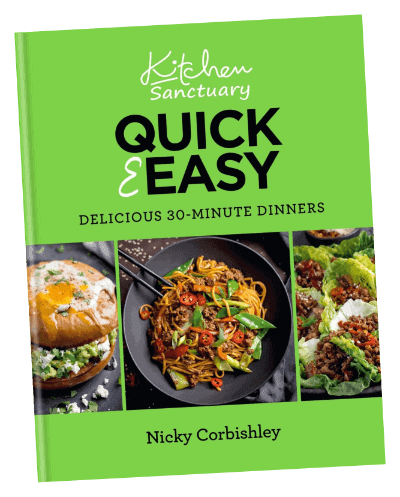
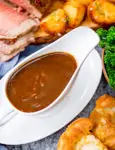
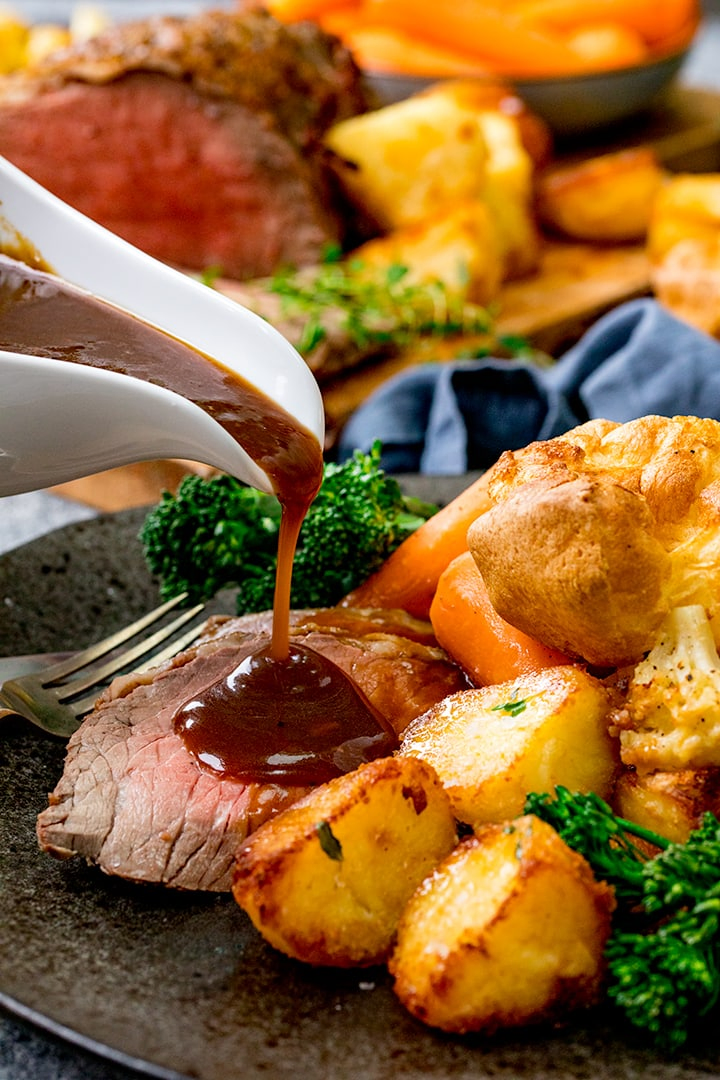
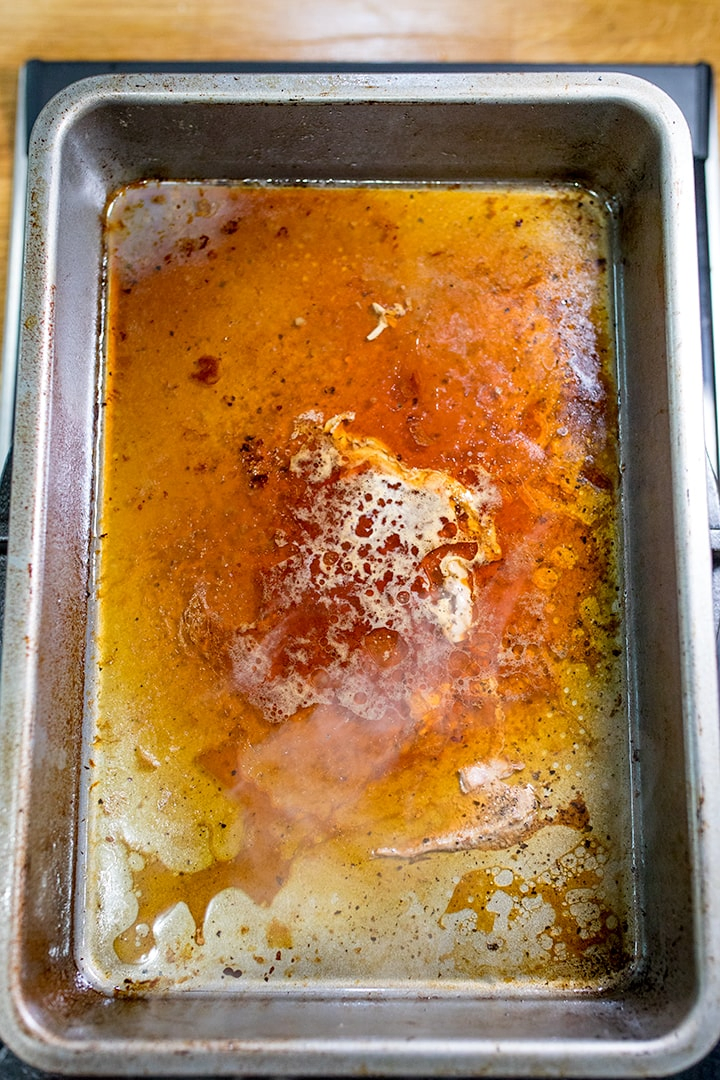
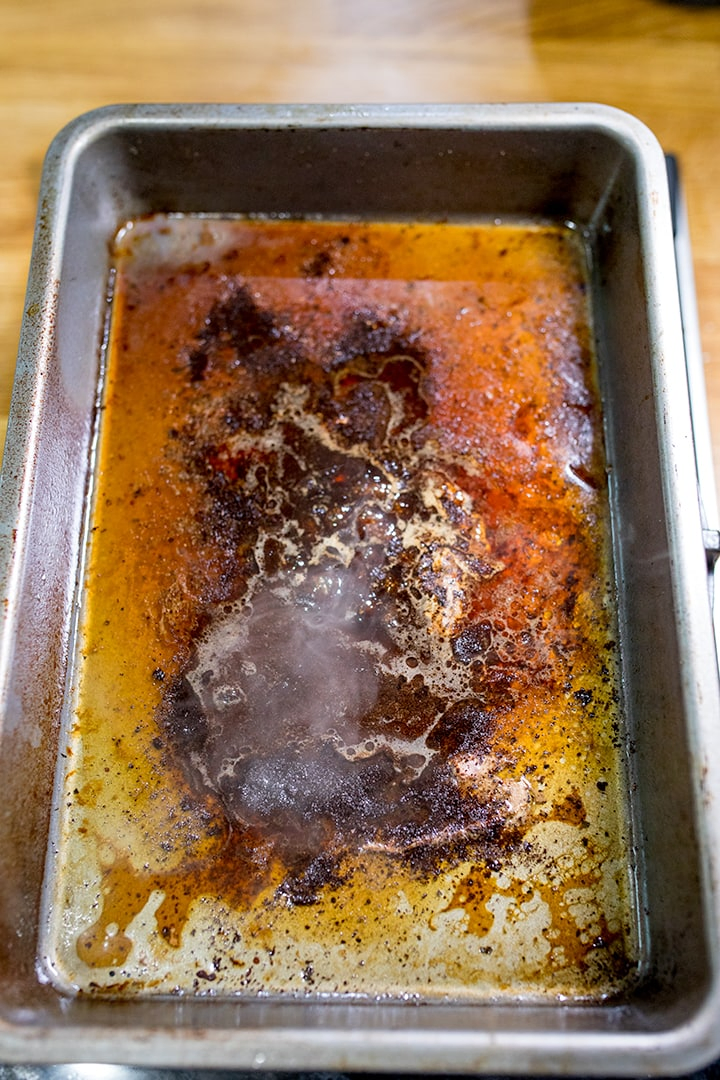
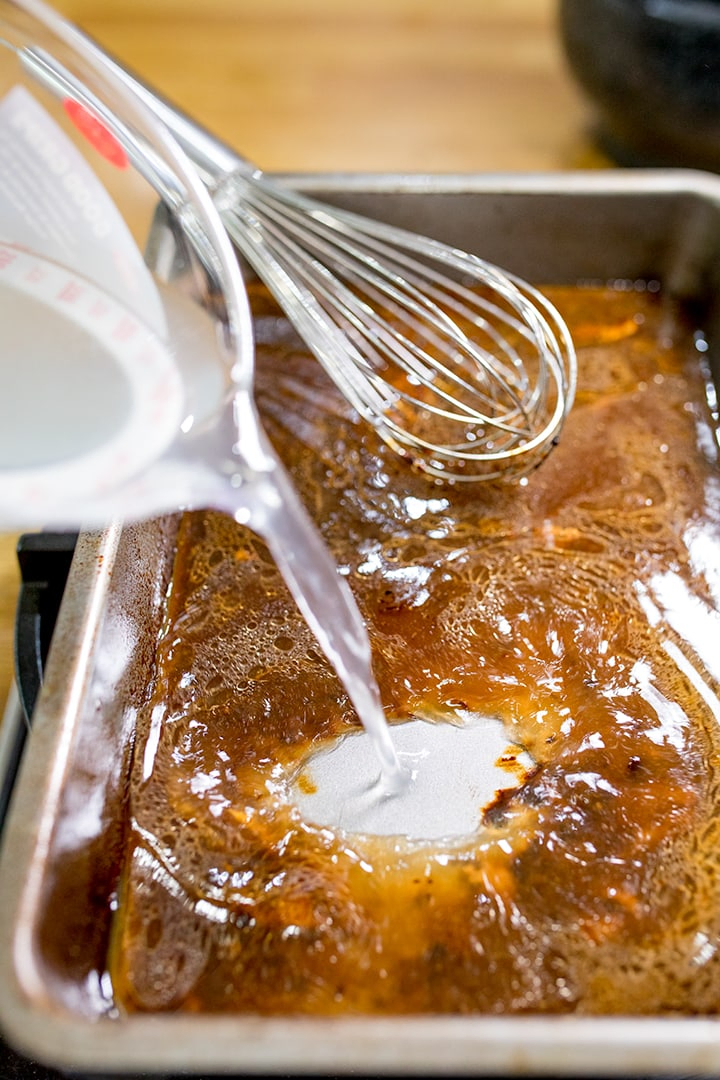
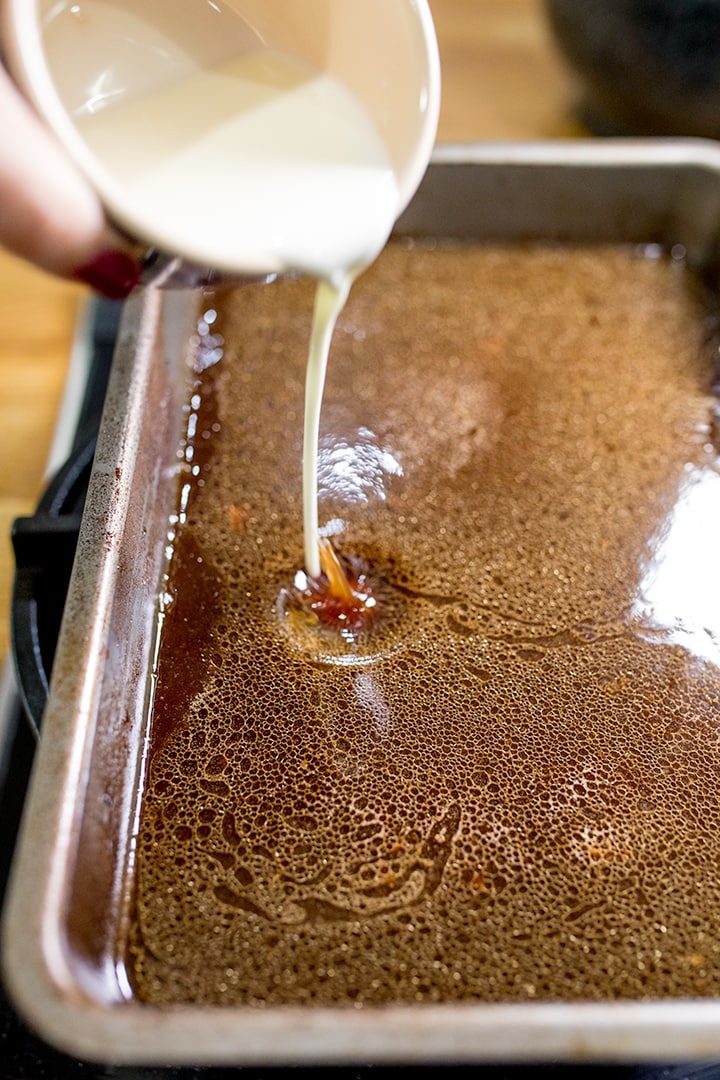
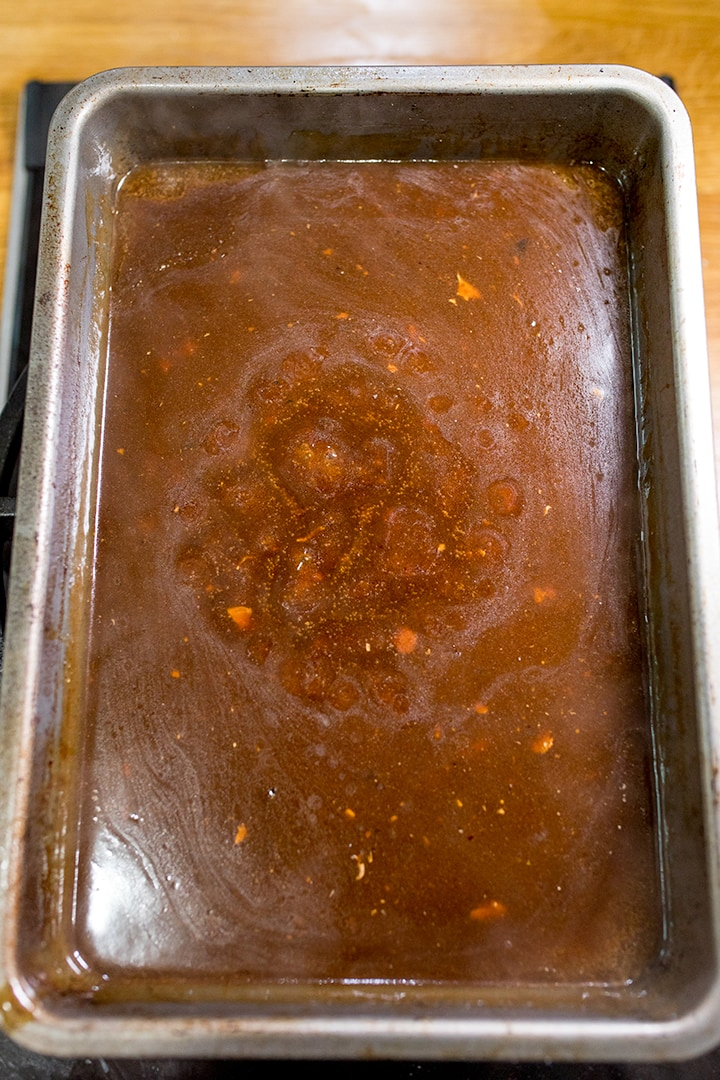


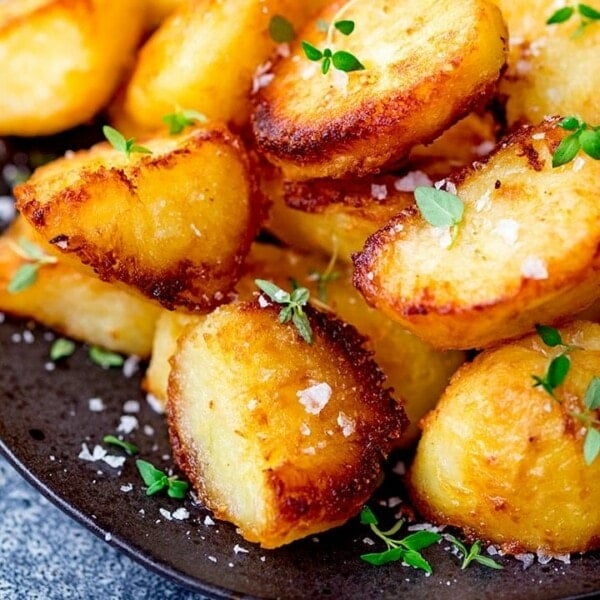
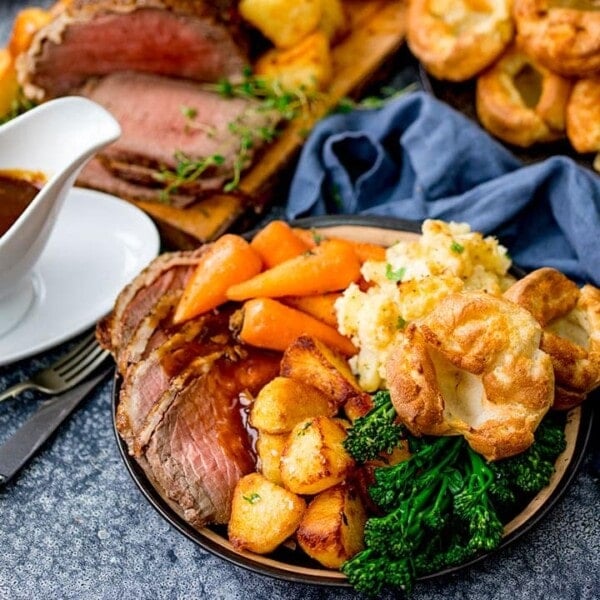
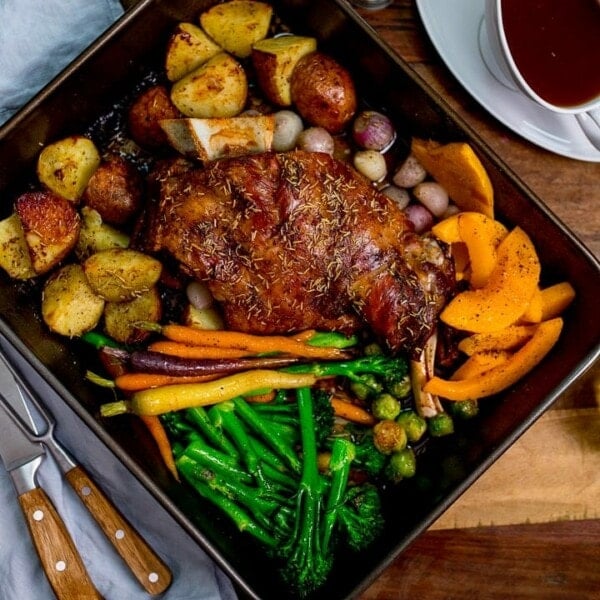
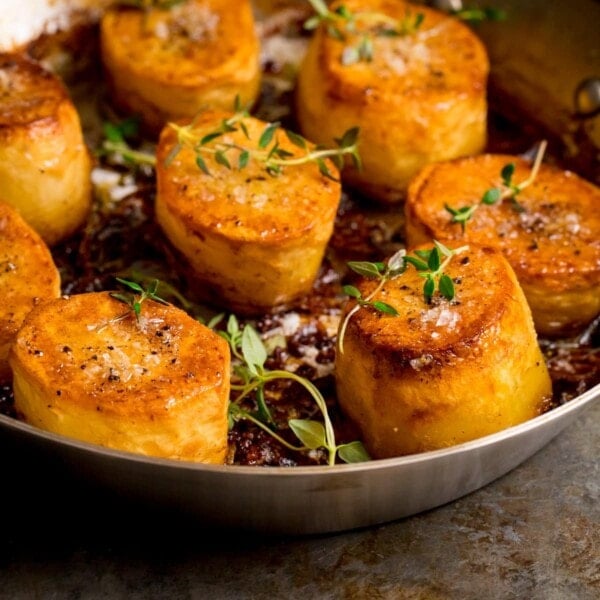
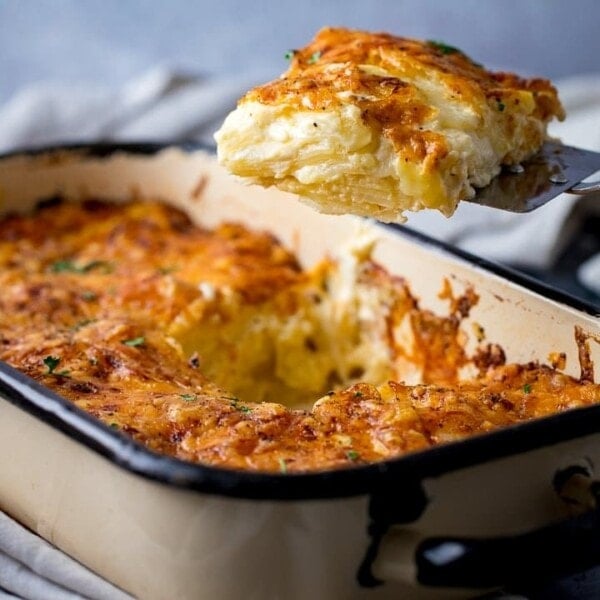
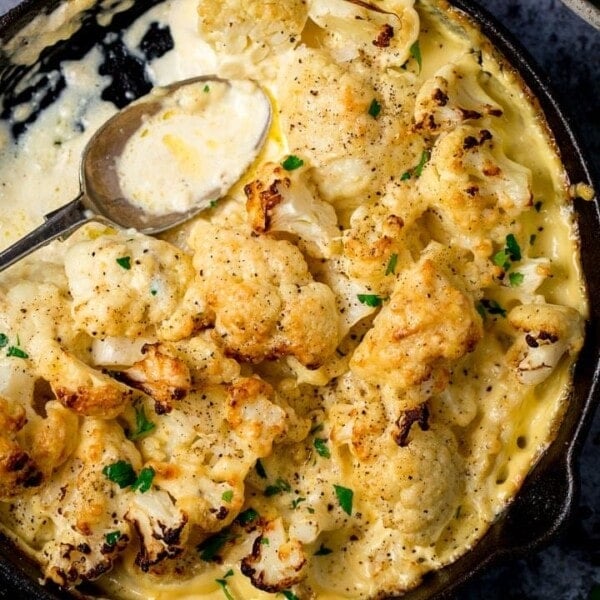
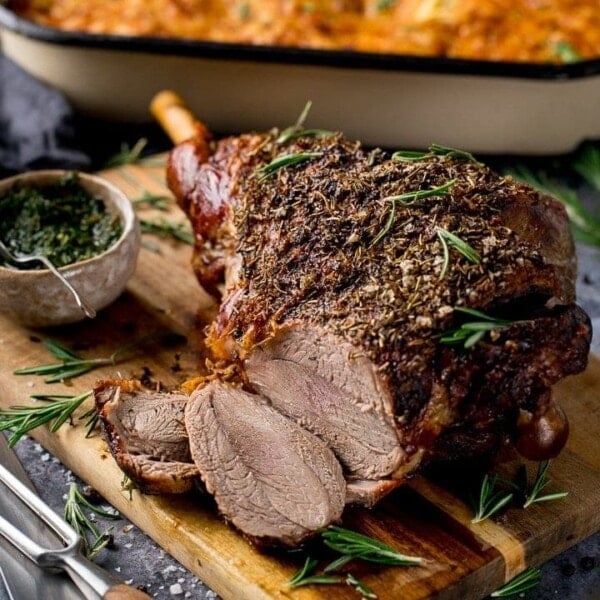







Hi Nicky; Just a word of thanks for getting back to me re my gravy question; very helpful.
Cheers
Jim
I will try this. I’m a gravy nut, and for me its the make or break ingredient in any meat based dinner.
I have always shied away from stock cubes, which I think was a throwback of living at home during the 60’s, so using them now will come as a bit of a culture shock. Still, if it helps in giving me a greater quantity of gravy then I’m game!
Hi Nicky, got your book the other day, always had a problem making gravy, tried your recipe on p. 209; turned out perfectly for my roast beef. Wondering if you have a recipe for gravy from scratch; when I haven’t meat juices. Thank you, Jim
Thanks Jim, so glad you enjoyed it!
Yes, I’ve got a full guide on gravy
Gravy with meat juices is always the best, but next best is by having some homemade stock on hand in the freezer from boiling up leftover meat bones. Then third best option is by using onions as the base, then the last option is by using a mixture of different stock cubes, to get a gravy with a rounded flavour.
About halfway down the post, you’ll find the section on ‘How to make gravy when you haven’t got any meat juices’. The post is here: How to make gravy
Gorgeous and simple.
I basically use your cornflour method with one exception. As soon as I take the meat from the pan I pour ice water into the pan. This immediately solidifies the saturated fat so you can scoop it off, leaving all the good tasty bits in the bottom of the pan. The water then dissolves all the meat juices left behind as you heat the pan. Like you I need to make a lot of gravy and this works really well.
Best Gravy EVER! thanks for the recipe